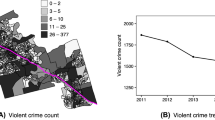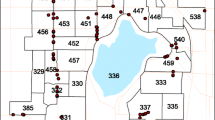Abstract
Past studies consistently indicate measurable local associations between alcohol distribution and the incidence of violence. These results, coupled with measurements of spatial correlation, reveal the importance of spatial analysis in the study of the interaction of alcohol and violence. While studies increasingly incorporate spatial correlation among model residuals to improve precision and reduce bias, to date, most analyses assume associations that are constant and independent of location, an assumption coming under increasing scrutiny in the quantitative geography literature. In this paper, we review and contrast two approaches for the estimation of and inference for spatially heterogeneous effects (i.e., associative factors whose impacts on the outcome of interest vary throughout geographic space). Specifically, we provide an in-depth comparison of “geographically weighted regression” models (allowing covariate effects to vary in space but only allowing relatively ad hoc inference) with “variable coefficient” models (allowing varying effects via spatial random fields and providing model-based estimation and inference, but requiring more advanced computational techniques). We compare the approaches with respect to underlying conceptual structures, computational implementation, and inferential output. We apply both approaches to violent crime, illegal drug arrest, and alcohol distribution data from Houston, Texas and compare results in light of the differing methodological structures of the two approaches.








Similar content being viewed by others
References
Alaniz MA, Cartmill RS, Parker RN (1998) Immigrants and violence: the importance of neighborhood context. Hisp J Behav Sci 20:155–174
Assunção RM (2003) Space varying coefficient models for small area data. Environmentrics 14:453–473
Besag J, York J, Mollie A (1991) Bayesian image restoration, with two applications in spatial statistics (with discussion). Ann Inst Stat Math 43:1–59
Brantingham PL, Brantingham PJ (1993) Nodes, paths and edges: considerations on the complexity of crime and the physical environment. J Environ Psychol 13:3–28
Brantingham PL, Brantingham PJ (1999) A theoretical model of crime hot spot generation. Stud Crime Crime Prev 8:7–26
Breslow NE, Clayton DG (1993) Approximate inference in generalized linear mixed models. J Am Stat Assoc 88:9–25
Brunsdon C, Aitkin M, Fotheringham S, Charlton M (1999) A comparison of random coefficient modelling and geographically weighted regression for spatially non-stationary regression problems. Geogr Environ Modell 3:47–62
Charlton M, Fotheringham S, Brunsdon C (2003) GWR 3: software for geographically weighted regression. Spatial Analysis Research Group, Department of Geography, University of Newcastle upon Tyne
Clayton DG, Kaldor J (1987) Empirical Bayes estimates of age-standardized relative risks for use in disease mapping. Biometrics 43:671–682
Cleveland WS (1979) Robust locally weighted regression and smoothing scatterplots. J Am Stat Assoc 83:829–836
Congdon P (2003) Modelling spatially varying impacts of socioeconomic predictors on mortality outcomes. J Geogr Syst 5:161–184
Congdon P (2006) A model for non-parametric spatially varying regression effects. Comput Stat Data Anal 50:422–445
Daniels MJ, Kass RE (1999) Nonconjugate Bayesian estimation of covariance matrices and its use in hierarchical models. J Am Stat Assoc 94:1254–1263
Draper NR, Smith H (1998) Applied regression analysis, 3rd edn. Wiley, New York
Dray S, Legendre P, Peres-Neto PR (2006) Spatial modeling: a comprehensive framework for principal coordinate analysis of neighborhood matrices (PCNM). Ecol Modell 196:483–493
Felson M (1987) Routine activities and crime prevention in the developing metropolis. Criminology 25:911–931
Felson M, Berends R, Richardson B, Veno A (1997) Reducing pub hopping and related crime. In: Homel R (ed) Policing for prevention: reducing crime, public intoxication and injury. Criminal Justice Press, New York, pp 115–132
Fotheringham AS, Brunsdon C, Charlton M (2002) Geographically weighted regression: the analysis of spatially varying relationships. Wiley, Chichester
Gamerman D, Moreira ARB, Rue H (2003) Space-varying regression models: specifications and simulations. Comput Stat Data Anal 42:513–533
Garofalo J (1987) Reassessing the lifestyle model of criminal victimization. In: Gottfredson MR, Hirschi T (eds) Positive criminology. Sage Publications, Newbury Park, NJ, pp 23–42
Gelfand, AE, Kim H-J, Sirmans CF, Banerjee S (2003) Spatial modeling with spatially varying coefficient processes. J Am Stat Assoc 98:387–396
Gorman D, Speer PW, Gruenewald PJ, Labouvie EW (2001) Spatial dynamics of alcohol availability, neighborhood structure and violent crime. J Stud Alcohol 62:628–636
Gorman DM, Zhu L, Horel S (2005) Drug “hot spots”, alcohol availability and violence. Drug Alcohol Rev 24:507–513
Greenberg M, Schneider DF (1994) Violence in American cities: young black males is the answer, but what was the question. Soc Sci Med 39:179–187
Griffith DA (2002) A spatial filtering specification for the auto-Poisson model. Stat Probab Lett 58:245–251
Group 1 Software (2003) Centrus desktop, version 4.01.01. Group 1 Software, Boulder, CO
Leyland AH, Langford IH, Rasbash J, Goldstein H (2000) Multivariate spatial models for event data. Stat Med 19:2469–2478
Lipton R, Gruenewald PJ (2002) The spatial dynamics of violence and alcohol outlets. J Stud Alcohol 63:187–195
McCullagh P, Nelder JA (1989) Generalized linear models, 2nd edn. Chapman and Hall, London
Nakaya T, Fotheringham AS, Brunsdon C, Charlton M (2005) Geographically weighted Poisson regression for disease association mapping. Stat Med 24:2695–2717
Nelson AL, Bromley RDF, Thomas CJ (2001) Identifying micro and temporal patterns of violent crime and disorder in the British city center. Appl Geogr 21:249–274
Pihl RO, Lau ML, Assaad J-M (1997) Aggressive disposition, alcohol, and aggression. Aggress Behav 23:11–18
Rice KJ, Smith WR (2002) Socioecological models of automotive theft: integrating routine activity and social disorganization approaches. J Res Crime Delinq 39:304–336
Roncek DW, Maier PA (1991) Bars, blocks, and crimes revisited: linking the theory of routine activities to the empiricism of “hot spots”. Criminology 29:725–753
Sampson RJ, Lauritsen JL (1994) Violent victimization and offending: individual-, situational- and community-level risk factors. In: Reiss AJ Jr, Roth J (eds) Understanding and preventing violence: social influences, vol 3. National Academy, Washington, DC, pp 1–114
Sampson RJ, Raudenbush SW, Earls F (1997) Neighborhoods and violent crime: a multilevel study of collective efficacy. Science 277:918–924
Schabenberger O, Gotway CA (2005) Statistrical methods for spatial data analysis. CRC, Boca Raton, FL
Scribner RA, MacKinnon DP, Dwyer JH (1995) The risk of assaultive violence and alcohol availability in Los Angeles County. Am J Public Health 85:335–340
Shaw CR, McKay HD (1947) Juvenile delinquency and urban areas. University of Chicago Press, Chicago
Smith WR, Glave Frazee S, Davison EL (2000) Furthering the integration of routine activity and social disorganization theories: small units of analysis and the study of street robbery as a diffusion process. Criminology 38:489–523
Spiegelhalter DJ, Best NG, Carlin BP, Van der Lind A (2003) Bayesian measures of model complexity and fit (with discussion). J R Stat Soc [Ser B] 64:583–616
Spiegelhalter D, Thomas A, Best N, Lunn D (2004) WinBUGS 1.4.1 user’s manual. MRC Biostatistics Unit, Cambridge
Stevenson RJ, Lind B, Weatherburn D (1999) The relationship between alcohol sales and assault in New South Wales, Australia. Addiction 94:397–410
Texas Department of Public Safety (2001) Crime in Texas 2000: the Texas crime report. Texas Department of Public Safety, Austin, TX
Tobler W (1970) A computer movie simulating urban growth in the Detroit region. Econ Geogr 46:234–240
Wakefield JC, Best NG, Waller LA (2000) Bayesian approaches to disease mapping. In: Elliott P, Wakefield JC, Best NG, Briggs DG (eds) Spatial epidemiology: methods and applications. Oxford University Press, Oxford, pp 106–127
Waller LA, Gotway CA (2004) Applied spatial statistics for public health data. Wiley, Hoboken, NJ
Weisburd D, Mazerolle LG (2000) Crime and disorder in drug hot spots: implications for theory and practice in policing. Police Q 3:331–349
Wheeler D, Tiefelsdorf M (2005) Multicollinearity and correlation among local regression coefficients in geographically weighted regression. J Geogr Syst 7:161–187
Acknowledgments
This work is supported in part by NIAAA contract HHW N28 1200410012C, “Ecosystem Models of Alcohol-Related Behavior.” The opinions expressed within represent those of the authors and not necessarily those of NIH or NIAAA.
Author information
Authors and Affiliations
Corresponding author
Rights and permissions
About this article
Cite this article
Waller, L.A., Zhu, L., Gotway, C.A. et al. Quantifying geographic variations in associations between alcohol distribution and violence: a comparison of geographically weighted regression and spatially varying coefficient models. Stoch Environ Res Risk Assess 21, 573–588 (2007). https://doi.org/10.1007/s00477-007-0139-9
Published:
Issue Date:
DOI: https://doi.org/10.1007/s00477-007-0139-9




